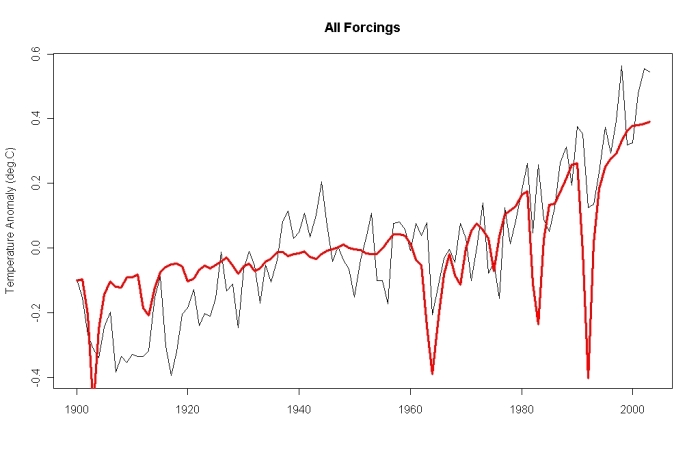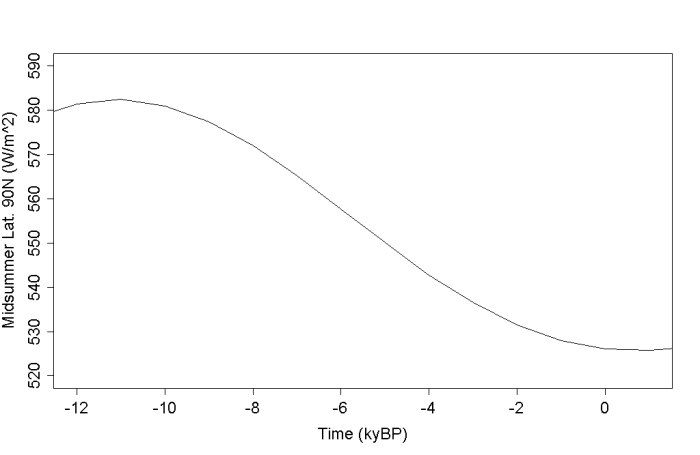Denialists love to denigrate computer models of earth’s climate. In my opinion they only do this because they’re in denial of the result, not because of any valid evidence. They also love to make the false claim that without computer models there’s no reason to believe that global warming is real, and is going to get worse.
The term “computer model” refers to an actual simulation of earth’s climate, often in remarkable detail. Such models are (of course!) not able to predict, or even post-dict, the chaotic aspects of the sytem (the weather), but they do an outstanding job of post-dicting the global statistical characterization of the system (the climate).
But such models and their results are not the topic of this post; I’d like to take a look at some simple models which are not computer models. They’re simple mathematical models of changes in global temperature, and although I’ve used a computer to do the arithmetic, I could have done so without a computer and they are most decidedly not computer models.
Global temperature responds to changes in the energy flow of earth’s climate system. When more energy flows through the system the planet heats up; with less energy flow the planet cools down. Changes in the energy flow constitute climate forcings. We know of many, including greenhouse gases, solar changes, ozone, snow albedo, land use, aerosols (both from volcanoes and from industrial processes), etc. We even have estimates of their magnitude for more than a century. For my mathematical models I’ll use estimates of climate forcing from NASA GISS; the data cover the time span from 1880 through 2003. Here’s the forcing data:
The only positive (warming) forcing which has reached a level greater than 1 W/m^2 (watt per square meter) above 1880 levels is greenhouse-gas forcing. The net forcing is strongly positive, but if we leave out greenhouse-gas forcing it’s not:

Many investigations of the relationship between climate forcing and global temperature use regression models. For such models, the response to climate forcing is treated as being instantaneous; there’s no (or at least negligible) lag between forcing and response. But that’s not a realistic model; there are many different components to the climate system, each with a different time scale. Hence in addition to simple regression models, I’ll also use a two-box model which allows for both a “prompt” response to climate forcing and a long-term response. This can be thought of as a rough mimicry of an atmosphere-ocean model, where the atmosphere responds quickly while the ocean takes much longer. I’ll allow the atmosphere to respond very quickly (in a single year) while for the oceans I’ll use a timescale of 30 years.
First let’s look at simple regression models, regressing global temperature against net climate forcing:
This model does show an overall increase in global temperature due to an overall increase in climate forcing. But two things are apparent: 1) the long-term trend is underestimated; and 2) the short-term dips (due to volcanic eruptions) are overestimated. It also indicates a climate sensitivity of only 0.25 deg.C/(W/m^2) (this is sensitivity to a forcing increase of 1 W/m^2, not sensitivity to doubling of CO2 concentration). That’s too low a value; the Stefan-Boltzmann equation alone implies a sensitivity of 0.3 deg.C/(W/m^2). Physics tells us that feedbacks in the climate system will make actual climate sensitivity greater than the Stefan-Boltzmann value, and paleoclimate evidence (ice age cycles) requires it.
The reason for the misfit is clear. Volcanic eruptions cause a huge negative (cooling) forcing, but the volcanic aerosols responsible for this forcing settle out of the atmosphere in a year or two so the effect doesn’t last very long, hence the response to a volcanic eruption is notable but not huge. But with only one response “coefficient” (this is a regression model with a single regressor, net forcing) this means the coefficient must be kept small enough not to cause immense cooling for every volcanic eruption. At the same time, long-term forcing changes cause warming, but if we set the regression coefficient small enough to create a good match with volcanic changes we’d see almost no long-term trend at all. Hence the long-term trend forces the coefficient to be big enough to get at least some trend.
The net result is that the regression coefficient is somewhere between the small coefficient of short-term response which matches volcanic changes, and the much larger coefficient of long-term response which matches global warming. As a result, the impact of volcanic eruptions is overestimated and the long-term trend is underestimated.
If we do a similar model using just greenhouse-gas forcing we get a decent (but not impressive) match to the long-term trend but the volcanic dips are now absent:
The match to warming during the early 20th century isn’t very good. Nonetheless it does show some early-20th-century warming, showing that claims that greenhouse gases had no impact until just recently are mistaken. Greenhouse-gas forcing is probably not the main driver of early-20th-century warming, but it’s not an insignificant factor either. Also this model shows even smaller climate sensitivity than the all-forcings regression model, a mere 0.24 deg.C/(W/m^2). However, the match to the long-term trend since 1975 is not bad, indicating that perhaps greenhouse-gas forcing is the main driver of global warming over the last 35 years or so.
If we use all climate forcings except greenhouse gases we get this:
Now the fit is dreadful! Also, the coefficient is of the wrong sign: the climate sensitivity using this model is -0.13 deg.C/(W/m^2), indicating that an increase in climate forcing causes cooling! What has happened is that without greenhouse-gas forcing, there’s simply no explanation for modern warming, so the model has fit the only variation it can find (modern volcanic eruptions) to recent warming, but had to reverse the sign to get any kind of match at all. Of course this model is nonsense.
If we try a simple regression model using just solar forcing, we can get a decent fit to early-20th-century warming but not to recent warming:
While the fit to the early-20th-century trend is not bad, the fluctuations of the solar (11-year) cycle just don’t match. This indicates that the coefficient from this model is probably too big — solar-cycle changes don’t cause that much warming and cooling. This is confirmed by examination of the coefficient from this model, indicating climate sensitivity of a whopping 1.73 deg.C/(W/m^2).
The fact is that while solar forcing is responsible for some of the early-20th-century warming, it didn’t cause all of it. The regression-on-solar-only model therefore must inflate the sensitivity to get a match. Even with inflated sensitivity it still doesn’t reproduce recent warming; solar output hasn’t increased.
The upshot of all the simple regression model results is that simple regression models (corresponding to prompt response to climate forcing) just don’t do the trick. Too little prompt response fails to show the trend we’ve observed, while too much prompt response exaggerates the effect of volcanic eruptions. Clearly we need to combine prompt response with long-term response in order to get a realistic picture of temperature change; that’s the purpose of the two-box model.
In fact the two-box model using all climate forcings does a good job fitting the observed data:
Both the early-20th-century and recent warmings are well modeled; the greatest mismatch is during the 1937-1945 period. It’s possible that some (if not most) of this mismatch is in the temperature data rather than the model, a result of the “bucket problem” with ocean temperature data-collection before and during world war II.
Another encouraging result of this model is that it yields a climate sensitivity of 0.73 deg.C/(W/m^2) (a sensitivity of 2.7 deg.C to doubling of CO2). This is well in line with the results of computer models; the GISS modelE shows a sensitivity of 0.68 deg.C/(W/m^2).
If we fit a two-box model but leave out greenhouse-gas forcing we get this:
Once again, without greenhouse-gas forcing the fit is dreadful. The only reason it matches recent warming is that it has turned the long-term forcing coefficient upside-down, and this model also shows a nonsensical negative climate forcing of -0.77 deg.C/(W/m^2). It emphasizes that without greenhouse-gas climate forcing (which is the result of human activity), climate models — even noncomputer models like these — just don’t fit.
I’ll close with a two-box model, which includes all climate forcings and includes the southern oscillation index to mimic some of the short-term changes in temperature. The SOI isn’t really climate forcing since it’s not adding or removing energy from the ocean-atmosphere system, it’s exchange between ocean and atmosphere. Nonetheless it is related to changes in surface temperature (which is what we’re modeling). I’ve allowed a 7-month lag for SOI to have an effect. I also computed a model allowing SOI to have a long-term effect, just as though it were a climate forcing — but the long-term impact of the SOI turned out not to be statistically significant. Here’s the result of the model including all forcings and short-term SOI effects:
The fit is excellent. The climate sensitivity indicated by this model is 0.69 deg.C/(W/m^2), extremely close to the sensitivity estimated from the (much more sophisticated) GISS modelE (computer) model of 0.68.
Many of you have seen the graphs (included in the IPCC reports) showing that using computer models, we can reproduce temperature history if we include human factors, but not if we omit them. That’s such powerful evidence that we’re the cause of global warming, it’s no wonder denialists have tried so hard to slander computer models and to insist that without them there’s no solid evidence of man-made global warming. The truth is that you don’t need computer models to show this. Even with very simple mathematical models (and these models are indeed simple) the result is the same. Without human causation, there’s no explanation for the global warming we’ve already observed. With human causation, there’s no explanation for a lack of global warming.
http://tamino.wordpress.com/2009/08/17/not-computer-models/




















